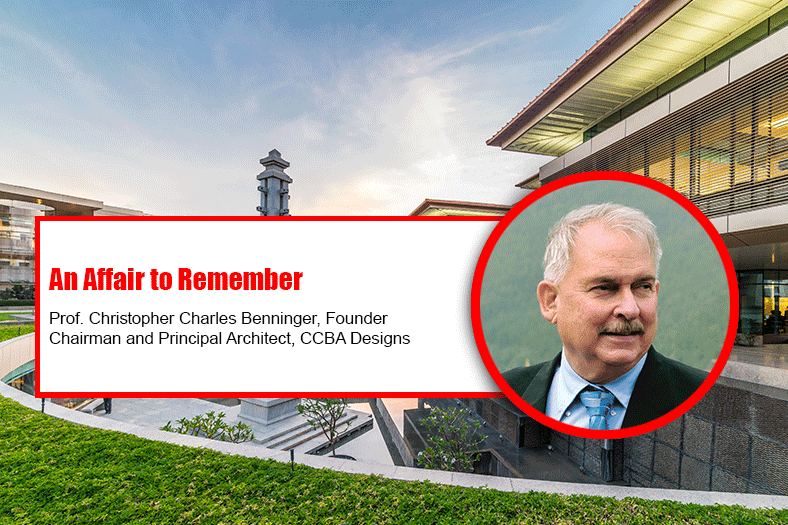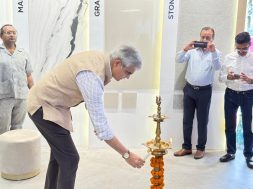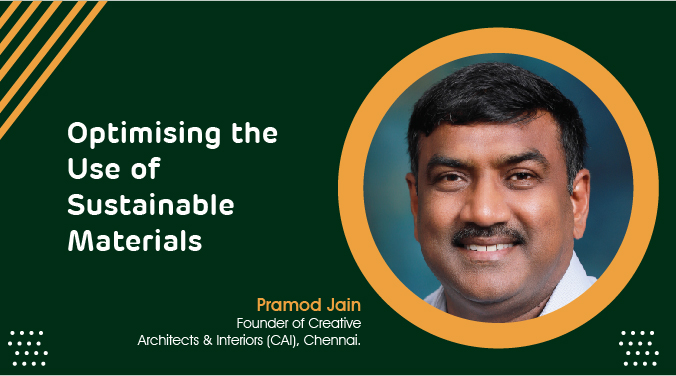An affair to remember

Prof. Christopher Charles Benninger, Founder Chairman and Principal Architect, CCBA Designs speaks on his love affair with India and his glorious journey in the world of architecture and design.
What is your idea of good design?
To quote Rumi: “Love is the whole and we are the parts!” Design begins with love of the whole, or love of place making, and with the two essential parts: love for humanity and love for nature. A good design has human scale and proportion and a cosy feeling for the users. A good design works for people. It also addresses its site, the natural context, and surrounding heritage, bringing nature into the spaces and linking the indoor spaces out into nature.
What led to the inception of CCBA?
I began my career working for the famous Spanish architect Jose Luis Sert, but also as a teacher at Harvard and at CEPT at a young age. I left Harvard in 1971 when I was 28 years old, at the invitation of Balkrishna Doshi, to set-up the School of Planning at CEPT in 1971. At the same time, I designed the Alliance Francaise in Ahmedabad; the first HUDCO funded low income housing project (1972) at Jamnagar; and the large Madras Site and Services program for fifteen thousand households, in what is now Chennai, for the World Bank. I shifted to Pune in 1976 to found the Centre for Development Studies and Activities, a post graduate teaching and research centre. During this period, I designed and built the CDSA campus and many students and young architects started visiting there, sketching, pondering, and they would often ask for a joint photo-shoot.
One day, during a shoot, just when we all said, “Cheese,” I realized that I was in the wrong profession. I should stick to architecture! At about the same time I met Akkisetti Ramprasad, a young AFMC doctor who was looking for a change too, and over coffee one evening in a garden café we decided to change our lives completely, leave our chosen professions and to start our studio. At just that same time I was asked by the Kochi Refineries to design their headquarters building, and Late Harish Mahindra asked me to design the Mahindra United World College of India. Lokamitra, the famous Buddhist, invited me to design the Nagaloka Centre in Nagpur. Fate was sitting with Ramprasad and me in that café one evening; we thought we had made a decision, but fate called to us to begin creating architecture.
What are the key differences in the way architecture and design is perceived in India and the developed nations of the world?
Western architects just want to do photogenic stunts and visual tricks that will get published. The humble Indian architect on the other hand is trying to solve functional problems, using appropriate low-cost materials and technologies and addressing severe climate issues, while our role models in the west just want to pull off a quick trick that will be published on the cover of a magazine.
I believe, in India we have great building traditions of space making, like the Chola Temple complexes of Tamil Nadu, or the cave complexes at Ellora and Ajanta. When I design in a strong regional context like in Bhutan, I employ the “culture of construction” of that region. In Bhutan, I used a creative pallet of local blue pine wood, indigenous stone and other local materials. Traditional craftsman showed me what I could do, and a monk from the Trashichhoedzong was our construction manager.
How has the face of architecture and design in India changed with increasing globalisation, is it good or bad?
(Laughs) The face of architecture has changed like the faces of our women have transformed with time! Less naturalness, more fake finishes! Not the real face, but an imported image and applique. It is not what you get, but what you see: packaging and fashion instead of “the way things are.” In the global sphere everyone is trying to look like someone else. In November 2018 someone on Facebook announced, “Beard Month!” Suddenly, boys became men with beards, and our architecture has responded too! Our streets are cluttered with cut and pasted images and false pretences. We have also found new materials and methods and this has encouraged us to experiment more with new finishes, structures and roofing. New building types like factories and workshops have challenged us, while we used to do cottages and apartment blocks.
How does your design approach differ when you are working on living or commercial spaces versus when you are executing a civic or an industrial project?
My design approach never changes as it is a methodology, step by step, rather than a hazy “approach.” It always begins with the client’sbrief followed by a site analysis. In the next step I draft a detailed bubble diagram for the desired level of space planning and organization. The bubble diagram is important because later phases of the design process are based on it.
Accordingly, there is a string of analytical tasks and an evolution of thoughts leading to several possible alternatives and choices. The client becomes an integral part of this iterative process. This is a very simplified brief of a very complex process involving fire rules and building control rules analysis, and the likes and dislikes of the client. Complex as it is, the process remains about the same, if it is a small school or a large campus design.
Among the various projects you have executed till date which one do you love the most and why? Likewise, which project was professionally a very challenging affair?
I love all of my designs because they are all my surrogate children. I have fathered them, schooled each in my mind, grew them up through my sketches, and seen them reach a mature reality on AutoCad. But I will always love my first and my smallest project most of all, which is the Alliance Francaise in Ahmedabad that I designed in 1973. I designed it using five materials: exposed brick and exposed concrete, Kota stone, mild steel and wood. As not to clutter the interior single flowing space, the sanitary units were “plugged” neatly into the back wall, gifting a nice accent. So, this was the mixing of a considered, rational matrix, with poetic instinct, making music out of exposed brick and concrete.
Who are some of the architects/designers you adore?
I don’t adore anyone except my lovers! But I do respect greatly people who taught me many things either through osmosis in a long association, or via didactics. I spent years with Balkrishna Doshi and I learned many inspiring things from him, and I came to know what a charismatic guru is. I had great teachers like Kevin Lynch at MIT and Jose Luis Sert at Harvard and from them I came to know what a true teacher is, and that teachers “give things” to their students. Anand Raje was a combination of the two, sharing great knowledge and making me laugh at the joke of life. Hasmukh C. Patel was our role model of how to be an honest professional, manage a good office and to respect our clients, as our patrons. The trick of life is to see that thin line of silver running through each and every person one meets, and glean from each person one chances upona piece of the truth of life.
How will Covid–19 change the rules of architecture and design in the post-pandemic world?
Social spacing is the new Covid-rule, yet common sense social distancing has been practiced in many societies like Japan for decades.In India we are a very “touch and feel” culture and a very social one of playing and mixing and living in close proximity. What we are going to do, hopefully, is correct past policy mistakes and urban planning errors; we will not see some profoundly new architectural patterns and shapes.
Just as we invented Special Economic Zones (SEZ) for Industry, we can now create Special Habitat Zones (SHZ) for communities where we sell affordable small plots of say 400 square feet each, and the present slum dwellers buy those on 30 years loans, and they build their own homes (as they do now) improving the quality over time. Now they will own their new self-built homes, and they will invest recycled materials, their own sweat equity, building with their own hands, and using appropriate materials. The government will gradually put potable water, electricity, sanitation and pathways in place.
These SHZs can be laid out within some of the expansive underutilized SEZ areas and large under-occupied industrial zones, like Chakan near Pune. Instead of socialdeserts, these industrial zones will become workers’ paradises, more multi-functional and integrated with recreation, health care, primary schools, technical and vocational educational facilities. If we are smart, we will react to the Covid-19 by getting rid of the congested, unsanitary red zone pockets where disease festers. I recommend immediately reducing the densities of our slums, redistributing lands within them and giving the choice to sixty percent of the inhabitants to seek a new life in SHZs!
Tell us about your love affair with India, what led you to embrace the nation and continue with your practice here itself?
My Janmabhoomi was America, but my Karmabhoomi is India! Yes, this life in India has been a love affair! The romance started in Ahmedabad in the 1960s during a year I spent on a Fulbright Fellowship, as a youth at CEPT, riding a rented HERO bicycle on dusty roads, watching Hindi films, no air conditioning, living in rustic hostels, no television, eating simple vegetarian food, no phones, and visiting the homes and villages of my hostel mates. I travelled a great deal in Saurashtra, the Panch Mahals, and South Gujarat.
I befriended hutment dwellers, princes, industrialists, famous scientists, villagers, renowned Bharatanatyam dancers, baniyas, architects, politicians and street hawkers.
I had read a great deal about Gandhiji, Jainism and the tenants of Vedic spiritual paths. I discovered my own inner path that I had not found at Harvard or MIT. Somehow during this year of emersion, meeting truly committed social workers like Sanatbhai Mehta, Kirtee Shah and Elaben Bhatt, hearing the birds singing in the morning, I felt I’d found my true Karmabhoomi. Everything fell into place and I discovered my path in life. I found something deep within me, calling out to me, that I had always known was there, living in my subconscious, perhaps from an earlier life that re-emerged from the heat and dust of India. That voice still calls out to me!
Cookie Consent
We use cookies to personalize your experience. By continuing to visit this website you agree to our Terms & Conditions, Privacy Policy and Cookie Policy.









